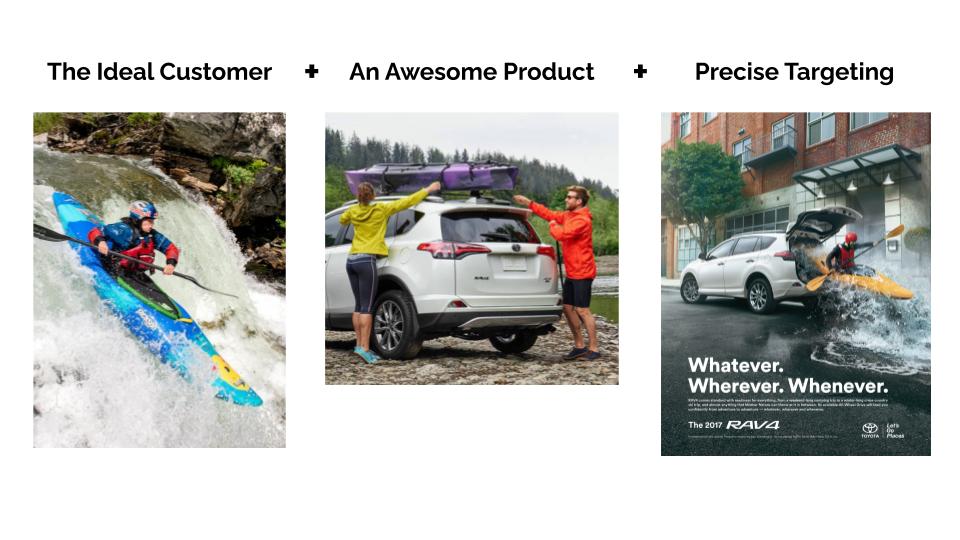Confused about what is product-market fit? Not sure if or when you have product-market fit? Befuddled about how to “find” product-market fit? Awesome, we got you!
This guide describes, in plain English and pictures, what is product-market fit, how to measure it, and how to create stronger product-market it.
Read to dive in? Let’s do it!
Chapter 1: What Is Product-Market Fit via Example
Let’s start with an example that hopefully everyone can relate to: buying and selling a car.
Imagine you are a carmaker, and you have made an awesome, sporty convertible.

Now imagine trying to sell your hot convertible to loggers working deep in the interior of Alaska.

It’s pretty unlikely that your convertibles are going to be flying off your deep-woods dealership lot. Sure, some loggers might buy your convertible and love driving it in the summer on dirt roads, but your convertible is probably going to be a poor fit for this market.

Now, let’s assume that you make a super durable and rugged pickup truck for the same customer segment. Your trucks probably will fly off the lot, and your customers will probably love what you are making and selling.

In the simplest terms, this is an example of strong product-market fit.
Finally, consider the case where you are also making a truck, but the truck is not well-made. The wheels fall off any time your truck hits a large hole or rock on the road, and it buckles under too much cargo weight.

You have the right kind of product, but a crappy product. Your logger customers won’t love it because it will leave them stranded and frustrated. This is still poor product-market fit, and your competitors will be able to out-compete you with a more durable truck.
Product-Market-Marketing Fit
Ok, here’s where things get tricky. What if you have the perfect product, you know who your ideal customer is, but you are not reaching the right customer?
Let’s break it down with another example.
You, the carmaker, have made an awesome, sporty convertible. You know that your ideal customers are men and women in their forties and in the middle-upper class living in warm sunny places like California and Florida. However, your marketing team spent all of your money advertising your convertible in Alaska, where you are much less likely to find your ideal customer.
Sales are flat and the few people that buy your convertible complain that it handles poorly in the snow. Do you have poor product-market fit? Not necessarily.
Just because your customers are not buying your product or are not satisfied does not mean that you have a bad product or don’t know who is your ideal customer. It could be that you just aren’t reaching the right customer, your ideal customer, and the wrong people are buying your product resulting in poor sales and unhappy customers.

Product-market fit is, therefore, a product of precise targeting as well; it’s the intersection of a great product, the ideal customer, and precisely targeting your ideal customer.
Chapter 2: When Do You Have Product-Market Fit?
It’s a bit clearer when your company has found product-market fit rather than the converse.
Some people describe product-market fit as holding onto a rocket ship as it shoots into orbit. Customers are pouring in, your company can’t hire people quickly enough, and investors are knocking down your door. It feels as though the wheels are going to come off and your company is barely able to keep it together.

I personally think this kind of description is not very applicable or helpful since even companies with strong product-market fit rarely enjoy that kind of astronomical growth.
Instead, what I have observed at companies with strong product-market fit is a bit less dramatic.
There are more subtle signs of product-market fit such as:
- Customers writing rave reviews about your product, thank you notes, and love letters;
- Strong organic growth such that if you turned off all of your marketing efforts, you’d still be gaining substantial amounts of customers or users;
- Low customer churn or high customer retention;
- High Net Promoter Scores (NPS).
I should note that all product categories are not created equal.
For example, the average Net Promoter Score for internet service providers is -1 while for online entertainment products it’s 47.
Therefore, if your startup delivers internet services to customers and has a Net Promoter Score (NPS) of 10, that’s pretty awesome. On the other hand, if your startup streams videos to users and has a Net Promoter Score of 35, that’s pretty miserable.
Due to this variation, surveys that measure consumer sentiment need to take into account your vertical or product category.

Another way to tell that your startup is reaching product-market fit is to look at how key metrics such as conversion rates and sales cycle times are changing. Key metrics will reflect when your company is tending toward stronger product-market fit:
- Conversion rates are increasing
- Sales value and revenue per customer are increasing
- Churn is decreasing
- Sales cycle times are decreasing
- Customer acquisition costs (CAC) decreasing

In the beginning, it will be easier to get the above metrics to move in the right direction as you hone in on your product and ideal market. However, as your startup gets closer to optimal product-market fit, which is ever-elusive, the rate of change will decrease as it becomes harder to make advances on any of the three fronts: product, market, messaging. The objective is to keep improving product-market fit until your efforts stagnate.
As you tend to optimal product-market fit, it might feel as though all of the friction in your startup has disappeared. It becomes much easier to acquire new customers and keep existing ones. Support volume slows down or even drops. You get relatively fewer angry emails or complaints about missing features or broken user experiences, and your customers become more vocal as they rave about your product or company on social media and elsewhere.
Conversely, when your company has poor product-market fit, it feels as though you are wading through molasses or pushing a cart uphill. The sense of friction is palpable. More concretely, all of the indicators that we described above are either trending the wrong way or are outside your industry benchmarks. For example, your churn rate might be significantly higher than other similar startups or you keep getting a flood of emails from customers complaining about your product’s poor user experience or missing features.
Chapter 3: How to Get Stronger Product-Market Fit
In math nerd terms, finding the optimal product-market fit is essentially finding the global maximum for a three-variable function.
In normal person terms, you have to improve the product, the targeting of your ideal customer, and
The objective is to fiddle with and test the product, market, and messaging in order to find a way to optimal product-market fit or as close to it as reasonably possible. And the trick is to start with those factors that are easiest to change. Usually, that is messaging, market, and product in decreasing order of difficulty. Let’s look at an example to illustrate this point.
The wrong messaging
Imagine that you have created a project management software for engineering and product teams. Specifically, your product excels at helping teams track tasks and bugs to address. Let’s say that your product really is exceptional at tracking engineering tasks and that the customer that you are targeting is hungry for a better solution than those existing in the market.
Unfortunately, the messaging on your website and advertising focus not on your product’s ability to seamlessly track tasks but rather on its team communication features. You have a superior product and a huge market that is hungry for a better way to track engineering tasks, but your
Engineering and product teams sign up and pay for your software expecting it to solve their communication needs, but it turns out that it falls short in that category. Consequently, many of your customers write angry support emails and abandon your product. Had
The wrong market
Going back to the above example of a project management software, let’s say that you are targeting dentistry offices in your marketing efforts. There is little chance that dentists and their staff are going to rave about your project management software even if you do a great job messaging the nature of your product and have a killer solution. Of course, this is an extreme and contrived example, and in reality, you are unlikely to miss the mark that badly. However, even subtle shifts to your targeting can have big changes in your product-market fit.
For example, if your project management software is really geared toward Scrum rather than waterfall methodology, those customers that are working in the latter will likely derive little value from your product and you will continue to have poor product-market fit even if you have a great product and are addressing the right general population of potential customers. Details matter. Of paramount importance is whether the customers that you are targeting have exactly the need that your product is addressing.
Luckily, optimizing the targeting of your marketing efforts is often a matter of changing the channel and perhaps messaging. It is usually a good idea to start experimenting via digital advertising since it’s easy to change and measure both messaging and channels. The more precise that you can define the audience and your product’s benefits, the quicker you’ll be able to hone in on the optimal market.
The wrong product
It goes without saying that product-market fit will elude your company if your product is not sufficiently better than existing solutions or is riddled with usability issues. Unfortunately, changes to the product itself require a greater time and material investment than adjustments to messaging or targeting making it more efficient to start with the latter and save changes to the product until your team feels confident in reaching the optimal market. There are times, however, when improvements should be make to the product in parallel to marketing optimizations.
Obvious usability issues and functional bugs should be addressed as quickly as possible since any user of your product will be able to spot them even if they aren’t the perfect target. It might make sense to pause and make sure that you are reaching the right customer before augmenting your product when customers are requesting features that don’t seem core to your product vision or when they are providing conflicting feedback.
Returning to the above example one more time, you’re core solution is making it easier for Scrum product and engineering teams to track tasks since that is where you see the greatest unmet need. If your current customers are loudly voicing the need for a more sophisticated chat feature, you should wonder if you are really reaching the right customers or even solving the right problem.
A Long Road to Product-Market Fit
It’s exceedingly rare for startups to find product-market fit right away even though such tales are glorified in the media. More commonly, optimizing product-market fit is a long journey sometimes lasting years as it had for Twitch, which created a great video streaming product but didn’t find the right market with Justin.tv for four years until they hit the jackpot with video gamers. The trickiest part is figuring out how strong your product-market fit is and whether you should turn your attention from trying to make it better to scaling your business.
